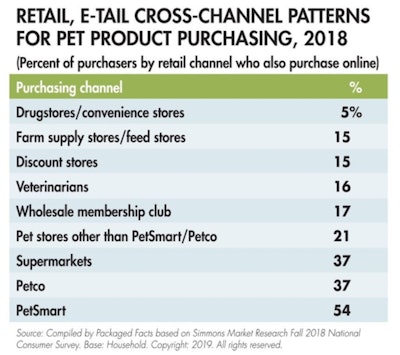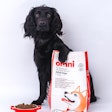
As recently as 2013 — though that’s a generation ago, in e-commerce time — the question was when online sales of pet products were truly going to take off. Simmons Market Research data show the needle moving only slowly on the number of dog- or cat-owning households in the U.S. who were buying pet products online, at 3 million in 2007 and 4 million in 2013. On a rounded whole percentage basis, factoring out a surge in dog ownership, that represented just 6% of dog or cat households in 2007 as well as in 2013.
The customer base for online purchasing of pet products then surged to 5.5 million in 2014 (9%), 8 million in 2016 (13%) and 13 million in 2018 (20%). Over the last several years, therefore, annual growth in this online customer base has doubled or tripled the aggregate growth from 2007–13.
What does ‘omnichannel’ look like in the pet product space?
On the way to this e-success, “omnichannel” replaced online as the smart-money term for understanding the role and potential of e-commerce in the pet products industry. The term omnichannel recognizes that brick-and-mortar vs. e-commerce is not — whether from a retailer, product category, brand or individual shopper perspective — an either/or proposition. Among PetSmart shoppers, for example, Simmons data show that 54% also buy pet products online (Table 1).

TABLE 1: Pet owners are no longer sticking to a single channel when purchasing their pet products.
Moreover, Packaged Facts survey data from February 2019 show that among customers who shop PetSmart or Petco in-store, 26% also buy pet products online specifically through PetSmart.com or Petco.com. Walmart.com, from the mass-market corner of the pet retailing arena, also claims a disproportionately strong draw for pet product shopping from its in-store pet department customers.
BOPIS (buy online, pick up in-store) further blurs the boundaries between brick-and-mortar and e-commerce. Packaged Facts survey data show that, among pet owners overall, 20% have ordered any type of products online to pick-up at a store and 14% have ordered any type of pet products online for in-store pick-up.
The evolution to ‘omnimarket’
In shifting perspective from omnichannel to “omnimarket,” the heterogeneity of leading e-commerce sites for pet product purchasing bears noting. Amazon.com (an online-based generalist) ranks first by pet product purchaser base, followed by Chewy.com (an online-based pet specialist acquired by brick-and-mortar based PetSmart). Next in line are Walmart (a brick-and-mortar based mass-market generalist) and then the namesake websites of PetSmart and Petco (as brick-and-mortar based pet specialists).
But the omnimarket range of material world and internet influences that shape not only where pet products are purchased, but which pet products and why, extends far beyond a mapping of retail channels. For example, pet shelters/rescue sources are now the top source for adoption of dogs and cats. Though not a pet product or service channel in any conventional mapping, pet shelters can therefore be very influential in “imprinting” the pet product (as well as vet/pet service) mentality of new pet owners, at this key juncture in establishing their pet care expenditure patterns.
Similarly, data compiled by Packaged Facts for the United Veterinary Services Association (UVSA) show that, after family and friends, the internet and social media are the top influences on new dog or cat adoption, both in the preliminary planning stage for adoption and in the actual acquisition of a new pet. Veterinarians, the traditional service channel, come to the fore as influencers only after the acquisition of the pet. Siteworthtraffic.com, moreover, shows the unique user traffic of pet adoption website Petfinder.com, which currently sports a banner ad for Purina, ranking in daily draw (at 30,497) with PetSmart.com (32,164) and Petco.com (31,304).
So if the term omnichannel still narrowly reflects a retailer perspective on where products are purchased, picked-up or delivered (in varying brick-and-mortar and e-commerce combinations), omnimarket is about the myriad sources of influence, information and innovation that are now shaping pet expenditure patterns and decisions. As pet owners become increasingly focused on specific pet care priorities, moreover, these expenditures often cross traditional and novel pet product and pet service classifications, as is evident in the rapidly diversifying market for pet nutrition.



















